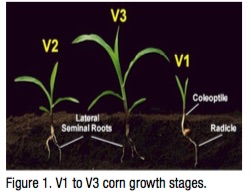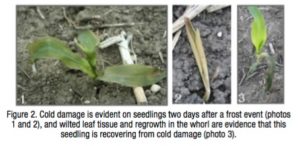Frost and Cold Temperature Damage to Small Corn
- Corn growth stage, air temperature, soil moisture, soil texture, and topography can influence potential cold injury to corn plants.
- Frost with temperatures above 28o F may damage seedling leaf tissue without necessarily injuring the growing point.
- Temperatures below 28o F may injure or kill the seedling growing point even if the growing point is below the soil surface.
- Growers should wait 3 to 5 days after a cold temperature event to accurately assess potential plant damage.
Corn Sensitivity to Low Temperatures
If frost occurs and temperatures remain above 28o F, corn has a good chance for recovery. Temperatures at or below 28o F for a few hours can be lethal to young corn plants and may kill the growing point even if it is still below ground. Typically the growing point will be below ground from the time corn spikes until the V5 growth stage. A pictorial guide to the location of the growing point at different corn growth stages is available online at http://www.kingcorn.org. If the growing point is below ground, corn can recover rapidly and completely from a moderate frost occurring before the V4 stage of growth. Losing the first 4 to 5 leaves may have minimal impact on corn yield potential.
To accurately assess the effects of a cold weather event, wait 3 to 5 days, look for evidence of new leaf growth from the whorl and split stems to evaluate the condition of the growing point. Cool days following a cold temperature event may delay recovery and the diagnosis of the extent of corn injury. Corn yield potential is primarily affected by stand loss, not the degree of leaf damage.
Symptoms of Cold Temperature Injury to Corn

During the first 24 hours after a cold temperature event, corn leaves may look yellow, silver,or brown, wilted, or water-soaked, due to the destruction of cells in damaged leaves(Figure 2). Several days later,leaves/plants may turn brown and die, but if the growing point is not damaged there is a good chance for recovery and survival, particularly if there is new green tissue in the whorl leaves. A white or cream-colored growing point that is still firm is an indication that the plant is recovering. Growing points that are darkened and soft are likely to die. If weather conditions are beneficial for recovery, a new leaf should develop three to four days after the frost. Occasionally, decaying leaf tissue may inhibit the growth of new leaves from the whorl, giving the corn seedling a twisted appearance. In most situations the new growth will grow through the decaying tissue. Continue to scout corn to detect any problems that may require corrective action.

Assessing Recovery Potential
The most important thing to do is wait 3 to 5 days before making a field by field assessment of frost damage. Determining the condition of the growing point will provide information to help determine the potential impact on final corn stand or replant decisions. The potential for corn recovery from cold temperature injury is greater for VE to V2 growth stage corn because energy reserves should still exist to support growth. The more green tissue a plant has to live on until regrowth occurs increases the likelihood of recovery. Dry, warm conditions will favor recovery. Multiple frost events or cool, damp weather can compromise recovery and plant health. Corn survival is dependant on a healthy growing point and new leaf growth. The best management practice is to exercise patience and scout corn. Evaluate the existing stand for potential survival and uniformity before deciding to replant. Compare the yield potential of the existing stand with the yield potential of a replanted stand.

